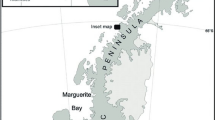Abstract
We examined the effect of prey type, repeated stomach flushing, digestion time, and meal size on the assessment of dietary intake of captive adult Cory’s shearwaters (Calonectris diomedea). For each of Cory’s shearwaters’ main prey type (fish, cephalopod, and crustacea), we used three different meal sizes and four digestion times, stomach-flushing the birds 1, 4, 8, or 16 h after feeding. On average, fish and cephalopods showed similar percentages of mass recovery (between 23% and 33%), whereas crustaceans showed a recovery about 10–15% greater. Conversely, fish and crustaceans showed similar percentages of items recovered (between 52% and 77%), whereas cephalopods showed about 10–35% greater recovery rates. We found no significant differences in the percentage of individual prey items recovered and the interval between ingestion and recovery, over intervals ranging from 1 to 16 h.

Similar content being viewed by others
References
Brown K, Ewins P (1996) Technique-dependent biases in determination of diet composition: an example with ring-billed gulls. Condor 98:34–41
Casaux RJ, Favero M, Barrera-Oro ER, P Silva (1995) Feeding trial on an Imperial Cormorant Phalacrocorax atriceps: preliminary results on fish intake and otolith digestion. Mar Ornithol 23:101–105
Catard A, Weimerskirch H, Cherel Y (2000) Exploitation of distant Antarctic waters and close shelf-break waters by white-chinned petrels rearing chicks. Mar Ecol Prog Ser 194:249–261
Cooper J, Henley SR, Klages NTW (1992) The diet of the Wandering Albatross Diomedea exulans at subantarctic Marion Island. Polar Biol 12(5):477–484
Creet S, Van Franeker JA, Van Spanje TM, Wolff WJ (1994) Diet of the Pintado petrel Daption capense at King George Island, Antarctica, 1990/91. Mar Ornithol 22(2):221–229
Duffy D, Jackson S (1986) Diet studies of seabirds: a review of methods. Colonial Waterbirds 9:1–17
Duffy D, Furness BL, Laugksch RC, Smith JA (1985) Two methods of measuring food transit rates of seabirds. Comp Biochem Physiol 82A(4):781–785
Gales RP (1987) Validation of the stomach-flushing technique for obtaining stomach contents of penguins. Ibis 129:335–343
González-Solís J, Oro D, Pedrocchi V, Jover L, Ruiz X (1987) Bias associated with diet samples in Audouin’s gulls. Condor 99:773–779
Granadeiro JP, Monteiro LR, Furness RW (1998) Diet and feeding of Cory’s shearwater Calonectris diomedea in the Azores, north-east Atlantic. Mar Ecol Prog Ser 166:267–276
Hilton GM, Houston DC, Furness RW (1998) Which components of diet quality affect retention time of digestion in seabirds. Funct Ecol 12:929–939
Jackson S, Ryan PG (1986) Differential digestion rates of prey by White-chinned petrels (Procellaria aequinoctialis). Auk 103:617–619
Monteiro LR (2000) The Azores. In: Heath MF, Evans MI (eds) Important bird areas in Europe. BirdLife International, Cambridge, pp 463-471
Robertson G, Kent S, Seddon J (1994) Effects of the water-offloading technique on Adele Penguins. J Field Ornithol 65:376–380
Walter CB, O’Neill E (1986) Electrophoresis in the study of diets and digestive rates of seabirds. Comp Biochem Physiol 84A(4):763–765
Weimerskirch H, Cherel Y (1998) Feeding ecology of short-tailed shearwaters: breeding in Tasmania and foraging in the Antarctic. Mar Ecol Prog Ser 167:261–274
Wilson RP (1984) An improved stomach pump for penguins and other seabirds. J Field Ornithol 55:109–112
Wilson RP, La Cock GD, Wilson MP, Mollagee F (1985) Differential digestion of fish and squid in Jackass Penguins Spheniscus demersus. Ornis Scand 16(1):77–79
Acknowledgements
We thank Ana Mendes, Ana Paixão, and Maria Carvalho for their valuable assistance conducting the experiment; Cédric d’Udeken d’Acoz for kindly identifying the crustacean; Prof. Malcolm Clarke and Dr. David Álvarez for their criticism and useful comments on an earlier version of the manuscript and for identifying the squid; and J. González-Solís and an anonymous referee for comments on the manuscript. This study was funded by the Portuguese Foundation for Science and Technology (grant PRAXIS XXI/BIC/17094/98 to V.C.N. and research contract PRAXIS/2/2.1/MAR/1680/95). The experiment performed in this study complies with Portuguese law and was conducted under licence number 1/98 issued by Direcção Regional do Ambiente.
Author information
Authors and Affiliations
Corresponding author
Additional information
Communicated by F. Bairlein.
L.R. Monteiro was tragically killed in a plane crash in the Azores in December 1999.
Rights and permissions
About this article
Cite this article
Neves, V.C., Bolton, M. & Monteiro, L.R. Validation of the water offloading technique for diet assessment: an experimental study with Cory’s shearwaters (Calonectris diomedea). J Ornithol 147, 474–478 (2006). https://doi.org/10.1007/s10336-005-0040-6
Received:
Revised:
Accepted:
Published:
Issue Date:
DOI: https://doi.org/10.1007/s10336-005-0040-6




